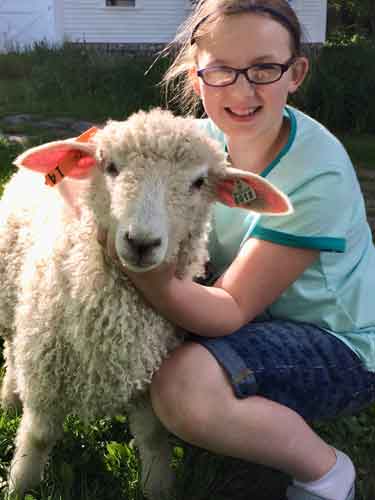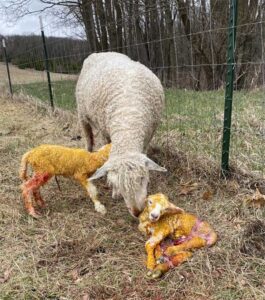 For centuries Heritage Cotswold sheep have acquired the following names:
For centuries Heritage Cotswold sheep have acquired the following names:
- Gentle Giants
- The sheep with the Golden Fleece
- The Poor Man’s Mohair
- Easy Keepers
- Great Mothers
- The Cotswold Lion
The traits that led to these names make them a wonderful addition to any farm, large or small.
Gentle Giants
While Cotswolds are a very large breed of sheep with the mature ewes weighing 175 to 230 lbs and mature rams 250 to 300+ lbs., they have a very gentle disposition. These large, white wooled sheep are polled (hornless) with black hooves and noses as well as small black spots on the ears. Cotswolds are friendly, love a good treat along with a scratch or back rub. Training them to follow a bucket full of corn is an easy thing to do and many will know their names.
The Poor Man’s Mohair with the Golden Fleece
A full year growth of an adult Cotswold fleece weighs over 10lbs; Lock lengths will be over 12 inches and the fleeces have a luster that is golden and beautiful. The wool from a Cotswold sheep has been in high demand for centuries. The wool is also claimed to be the whitest of whites and takes dye exceptionally well.
Much has been written about Cotswold wool but the best story has to be the following. In 1892, W.S. Harmer of the British Cotswold Sheep Society wrote that a Cotswold fleece was a part of the Golden cloth from Antiquity. Its wool, spun fine, had been woven with strands of gold to make the special garment for ancient kings and priests. Is this truth or a tall tale? The glow of a Cotswold fleece just might lead one to think it could be true!
Cotswold wool has also been called the “Poor Man’s Mohair”. The luster and curls of a Cotswold look like Mohair but processing adds another level of similarity. There are two different yarn types that can be processed from wool: a worsted yarn or a woolen yarn. If wool fibers are hand-combed with wool combs making the fibers align in the same direction as they grew on the sheep and these aligned fibers are then spun into a yarn, a true worsted yarn has been produced that has very little itch or roughness factor. A Cotswold worsted yarn is very soft and feels just like Mohair with a luster that glows.
Cotswold sheep can be sheared either once or twice a year.
Easy Keepers
Cotswolds are a very hearty breed who do well on mediocre pastures with limited grain. They can definitely get fat just by eating grass and too much grain can lead to health issues. There are many breeders who add grain or corn to the diet only when flushing and post lambing.
Compared to the other long wool breeds, the Cotswold breed is the only “hill breed” of the long wool group. Hill breeds are typically heartier sheep as they have had to survive in less than ideal conditions leading to strong genetics. Cotswold sheep do not flock together tightly but spread out which helps to even out pasture forage. They do well outside even in the cold and snow but shepherds need to watch if they become wet and cold.
It is important to note that long wool breeds are slow growers, maturing to full growth around 2 years of age. They are a great sheep to utilize for regenerative farming practices such as rotational grazing or on grass fed operations. As with all sheep, shepherds must manage parasites, body condition, and overall health. Listed below are websites for Famancha training and sheep care. Where a farm is located, its facilities, how much pasture and the quality of the pasture forage can really impact a shepherd’s management practices. New shepherds should look for multiple mentors as they start on their journey with sheep contacting local extension offices, University Systems, Farm Service Agency (FSA), the National Resource Conservation Service (NRCS), state grazing groups, Fibersheds and of course, The Livestock Conservancy can be really helpful.
Cotswolds have a very mild meat whether it is from a lamb, hogget or mutton.

Great Mothers
Easy lambing has been a claim to fame for the Cotswold sheep. Structurally, the pregnant ewes have a cone shaped flank and a wide pelvic structure. The lambs have small heads with long necks. All of these factors have been associated with easier births. The one caveat is that an over fed ewe will have more issues with lambing.
New lambs once dried off and nursed are extremely hardy. Lambs are typically quick to stand and start nursing within 15-30 minutes of birth. Cotswold mothers are very attentive, often cleaning one lamb while birthing another. Cotswold mothers make a good amount of milk and are very good at directing the new lamb to the teat.
Cotswold sheep can still be producing sheep past 10-12 years of age. The average length of gestation is around 150 days.
The Cotswold Lion
There is a time of year where a Cotswold sheep with a full curly coat of golden fleece will be standing in the pasture and the light will hit him or her just right showing off the “lion”. It is a sight to behold. Strong and majestic is the Heritage Cotswold sheep. It has had an interesting and unique history and hopefully a future that will be bright!
The American Cotswold Record Association is here to help new shepherds raise Cotswold sheep and connect current shepherds. The following are wonderful resources for all shepherds to have on hand. Also check out the ACRA newsletters posted on this website.
Sheep 101
Sheep 201 - A Beginner's Guide to Raising Sheep
American Consortium for Small Ruminant Parasite Control
Sheep Gestation Calculator
Shave ‘Em to Save ‘Em Initiative (SE2SE)
Sheep Resources for Small Farms
Nutritional Requirements of Sheep
Lamb and Wool Management: Introduction to Sheep Management

